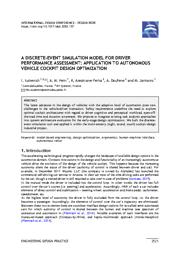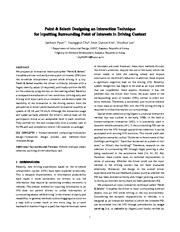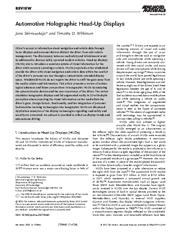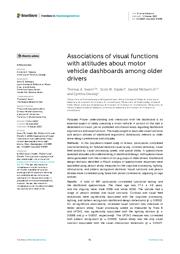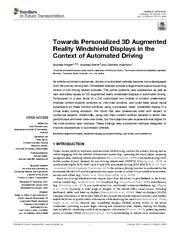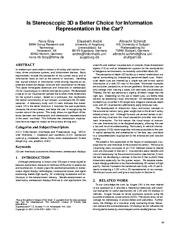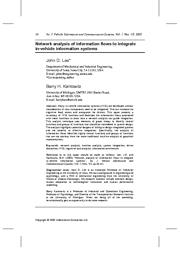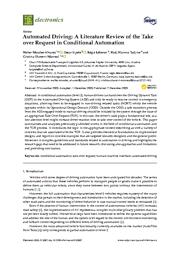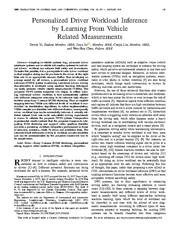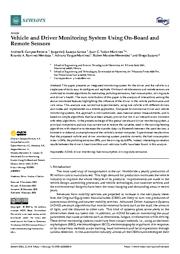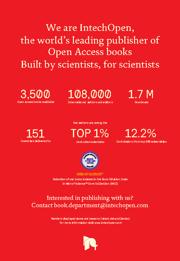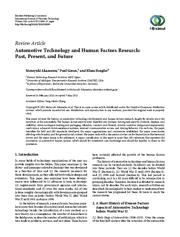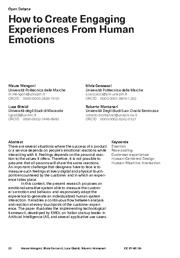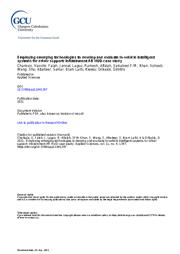A copy of this work was available on the public web and has been preserved in the Wayback Machine. The capture dates from 2020; you can also visit the original URL.
The file type is application/pdf.
Filters
A DISCRETE-EVENT SIMULATION MODEL FOR DRIVER PERFORMANCE ASSESSMENT: APPLICATION TO AUTONOMOUS VEHICLE COCKPIT DESIGN OPTIMIZATION
2020
Proceedings of the Design Society: DESIGN Conference
Safety requirements underline the need to explore optimal cockpit architectures with regard to driver cognitive and perceptual workload, eyes-off-the-road time and situation awareness. ...
Examples of design decisions Change textual message "AD mode is available" on icon "AD" and reallocate it to Head-up display Change textual message "L1 is activated" on icon "L1" on the Instrument cluster ...
Cognitive simulation models Approaches based on task analysis treat the driver's cognition as a black-box (tasks play the role of inputs and outputs). ...
doi:10.1017/dsd.2020.157
fatcat:b3biquopr5bydpimh773dzz6oa
Point Select: Designing an Interaction Technique for Inputting Surrounding Point of Interests in Driving Context
[article]
2022
arXiv
pre-print
Although the interaction usage and speed partially affected the driver's mental load, all the participants drove at an acceptable level in each condition. ...
The front view of the vehicle was displayed on a 55 inch TV, and the vehicle digital cluster was displayed on the top half of a 22 inch monitor. ...
Recently, design exploration was carried out on in-vehicle displays such as center fascia, head-up display (HUD), and digital instrumental cluster (DIC) [40] . ...
arXiv:2201.06451v1
fatcat:6m42qdvkxrhdbl4h7yinna6cpa
Automotive Holographic Head‐Up Displays
2022
Advanced Materials
Driver's access to information about navigation and vehicle data through in-car displays and personal devices distract the driver from safe vehicle management. ...
The review elucidates holographic displays and full augmented reality (AR) in 3D with depth perception when projecting the visual information on the road within the driver's gaze. ...
[59] The driver's cognitive and sensory abilities need to be balanced with the driver's needs for windshield HUDs. ...
doi:10.1002/adma.202110463
pmid:35148445
fatcat:zqssquircraxjf4fbp2lidlmae
An Ecological Interface Design Approach for Developing Integrated and Advanced In-Vehicle Information System
2016
Indian Journal of Science and Technology
characteristics; 4) Standardization through Customization. ...
Information requirement analysis based on the Skill-Rule-Knowledge framework was conducted to classify the level of driver's cognitive load when interacting with modern car functions. ...
If somehow the car manufacturers could adapt a principled and standardized approach for distributing information based on the characteristics of each display used in the IVIS and the driver's experience ...
doi:10.17485/ijst/2016/v9i16/92038
fatcat:rxlgspdtw5bilabflgpc3bfs2u
Associations of visual functions with attitudes about motor vehicle dashboards among older drivers
2022
Frontiers in Neuroergonomics
Future automotive engineering and design initiatives should consider these associations in improving dashboard designs to increase vehicle utility and accessibility. ...
Contrast and visual field sensitivities were significantly associated with the cognitive processing, lighting, and pattern recognition dashboard design dimensions (p ≤ 0.0052). ...
As vehicles transition to digital displays and controls, there are many opportunities for enhancements in the dashboard's configurable displays, and importantly, designs can be considered that are driverspecific ...
doi:10.3389/fnrgo.2022.918781
pmid:38235469
pmcid:PMC10790864
fatcat:flgeqaxpqra6xjyudr5vq6z53m
Towards Personalized 3D Augmented Reality Windshield Displays in the Context of Automated Driving
2022
Frontiers in Future Transportation
These findings help automotive interface designers to improve experiences in automated vehicles. ...
Windshield displays provide a large screen space supporting drivers in non-driving related activities. ...
Feedback design should therefore consider the driver's viewing direction, maybe regardless of the driver's personal preference towards a specified area of the WSD to display notifications/warnings. ...
doi:10.3389/ffutr.2022.810698
fatcat:rjrasw2qqvardi6ynufkv3b45a
Is stereoscopic 3D a better choice for information representation in the car?
2012
Proceedings of the 4th International Conference on Automotive User Interfaces and Interactive Vehicular Applications - AutomotiveUI '12
In contrast to these investigations, the domain of automotive user interfaces has to consider the primary driving task. ...
It is possible to choose between several views to configure the displayed information pertaining individual requirements. ...
doi:10.1145/2390256.2390270
dblp:conf/automotiveUI/BroyAS12
fatcat:viox5cve2jab7dwg24x6zmkvde
Network analysis of information flows to integrate in-vehicle information systems
2005
International Journal of Vehicle Information and Communication Systems
This can increase the cognitive load, errors and annoyance for drivers. ...
This analytic technique uses elements of graph theory to identify central functions and groups of functions that should be considered in system design. ...
In particular, driver monitoring requires knowledge of the driver's use of other in-vehicle functions to estimate the driver's cognitive state. ...
doi:10.1504/ijvics.2005.007584
fatcat:32n4ceqhmfcf5jzwszsyi3unii
Automated Driving: A Literature Review of the Take over Request in Conditional Automation
2020
Electronics
In this case, the driver's state plays a fundamental role, as a low attention level might increase driver reaction time to take over control of the vehicle. ...
individual characteristics. ...
To this end, a DMS relies on the driver's physical responses and environment perception to estimate their cognitive state [16, 54] . ...
doi:10.3390/electronics9122087
fatcat:x2d42oex7fayxoegi3mjyrvuzu
Personalized Driver Workload Inference by Learning From Vehicle Related Measurements
2018
IEEE Transactions on Systems, Man & Cybernetics. Systems
Rather than developing an average model for all drivers, a personalized driver workload inference (PDWI) system considering individual drivers driving characteristics is developed using machine learning ...
In offline training, individual drivers workload is first automatically splitted into different categories according to its inherent data characteristics using fuzzy C-means (FCM) clustering. ...
For example, to make ADAS cooperate better with human drivers, personalized driver steering model is developed in [1] by considering each driver's desired path. ...
doi:10.1109/tsmc.2017.2764263
fatcat:j22j6gqhlzeibp3gupr2yf6ity
Vehicle and Driver Monitoring System Using On-Board and Remote Sensors
2023
Sensors
This paper presents an integrated monitoring system for the driver and the vehicle in a single case of study easy to configure and replicate. ...
Indeed, interesting correlation results between the driver's heart condition and vehicular traffic have been found in this analysis. ...
In addition, it allows the configuration for easy use, that once configured and defined, it can work automatically without the need to re-configure and start the data collection. ...
doi:10.3390/s23020814
pmid:36679607
pmcid:PMC9865487
fatcat:uzpk3mrbbjfivdvgrn5ehdscly
Physical Variable Analysis Involved in Head-Up Display Systems Applied to Automobiles
[chapter]
2011
Augmented Reality - Some Emerging Application Areas
(HUD) systems represent a significant breakthrough in terms of automotive safety. ...
Cognitive capture Under high working conditions there is a high level of temporary uncertainty for the unexpected appearance of outer objects, consequently, it is likely that a cognitive capture occurs ...
Physical Variable Analysis Involved in Head-Up Display Systems Applied to Automobiles, Augmented Reality -Some Emerging Application Areas, Dr. ...
doi:10.5772/25849
fatcat:7parr65yafabjfieefvg4kjwae
Automotive Technology and Human Factors Research: Past, Present, and Future
2013
International Journal of Vehicular Technology
The human factors aspects were classified into primary driving task aspects (controls, displays, and visibility), driver workspace (seating and packaging, vibration, comfort, and climate), driver's condition ...
A major contribution of this paper is more than 180 references that represent the foundation of automotive human factors, which should be considered core knowledge and should be familiar to those in the ...
A shift in human factors research began from a focus on physical characteristics to cognitive characteristics. ...
doi:10.1155/2013/526180
fatcat:rvyawpbbr5fzjiutl7fhiktgbu
How to Create Engaging Experiences From Human Emotions
2021
DIID
The HU-Drive solution consists of two modules: module 1 recognizes the driver's emotional and cognitive state from images which are captured by cameras inside the cockpit and processed by Deep Neural Networks ...
Based on the cluster, the system proposes a journey across the museum by visualizing different artworks. ...
doi:10.30682/diid7421b
fatcat:7gapxgkitfdy7o42d6kermdlfu
Employing Emerging Technologies to Develop and Evaluate In-Vehicle Intelligent Systems for Driver Support: Infotainment AR HUD Case Study
2021
Applied Sciences
The latter is achieved through the use of an augmented reality (AR) head-up display (HUD) system, which projects the information within the driver's field of view. ...
The proposed system was evaluated in contrast to a typical head-down display (HDD) interface system by 30 users, showing promising results that are discussed in detail. ...
Additional characteristics could be included to challenge further driver's ability to respond. ...
doi:10.3390/app11041397
fatcat:yvjb65reojhkdo3my7fbrrbgci
« Previous
Showing results 1 — 15 out of 312 results

